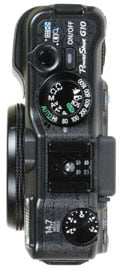Canon PowerShot G10
-
-
Written by Gordon Laing
Intro
Canon’s PowerShot G10 is the latest model in the company’s flagship G-series, designed to satisfy the demands of enthusiasts who want a powerful compact or a pocketable backup to a DSLR. Announced in September 2008, it’s the successor to the popular PowerShot G9 and retains a number of its key specifications including full manual exposure control, a flash hotshoe, RAW recording, and a retro-styled body – albeit with some control enhancements.
The PowerShot G10’s headline feature is a new lens with a 5x optical range that’s equivalent to 28-140mm. This may be shorter than the 6x range of its predecessor, but crucially equips the G10 with wider angle coverage of 28mm compared to 35mm. This better-equips the G10 when faced with expansive landscapes, large buildings, cramped interiors or big group shots.
| |||
 | |||
Inevitably there’s been a boost in resolution from 12.1 to 14.7 megapixels, making the G10 one of the highest resolution compacts on the market. To make the most of the detail captured, the G10 importantly retains the RAW recording facility of its predecessor – this is a crucial specification for enthusiasts and it’s the only non-DSLR in Canon’s current range to offer it.
Handling the number crunching is Canon’s latest DIGIC 4 processor which brings a number of enhancements to the camera, including more efficient H.264 compression for video (albeit still in standard definition), improved face detection, a new self-timer option which exploits face detection to wait for the photographer to enter the frame, motion detection, a new Servo AF mode, and i-Contrast which can boost shadow areas in images.
The screen remains a 3in model, but Canon’s upgraded the resolution from 230k to 460k pixels, allowing it to display much finer detail in composition and playback, along with allowing much smoother menu fonts. The new screen also has a very wide viewing angle.
 |
The retro-styled body remains essentially the same as the earlier G9, but there’s some control changes on the upper panel with the dedicated ISO dial shifting to the right, where it’s now positioned under a smaller mode dial in a two-tier arrangement. The vacated area on the upper left side is now home to a new exposure compensation dial. Along with the thumb wheel on the rear, these large and satisfyingly tactile controls make the G10 quick and easy to operate. As before, the G10 also features full PASM modes for manual control over exposure.
Completing the picture as mentioned earlier is a flash hotshoe, which allows the G10 to use selected Canon Speedlite flashguns, and if you mount the Speedlite 430EX II or 580EX II models, you can even enjoy the same built-in control over them as Canon’s DSLRs.
So the new PowerShot G10 may still not feature the f2.0 lens or flip-out screen of earlier G-series generations, nor does it boast HD video recording or any kind of HD output as seen on rival compacts from Panasonic, but with full manual control, wide angle coverage, high resolution, a flash hotshoe, RAW recording and a great-looking screen, it still represents a compelling prospect for enthusiasts.
 |
In our Canon PowerShot G10 review we’ll examine the new features and performance of the camera, comparing it to its predecessor and key rivals like the Panasonic Lumix LX3. In our image quality section we’ll also see how it measures-up against a DSLR, along with a lower-end compact in Canon’s range to see just how good the combination of its new high resolution sensor and DIGIC 4 processor really are.
And as always, for a demonstration of its key features, check out our Canon PowerShot G10 video tour. Ultimately, can the PowerShot G10 satisfy the demands of enthusiasts and those wanting a pocketable alternative to a DSLR? Find out over the following pages.
Testing notes
Following our convention of using default factory and best quality JPEG settings to test cameras unless otherwise stated, the PowerShot G10 was set Large SuperFine quality, Auto White Balance, Evaluative Metering and with ‘My Colours’ switched off (the default setting for contrast, saturation and sharpening).
Support this site by checking prices above or shopping via our affiliate stores |




